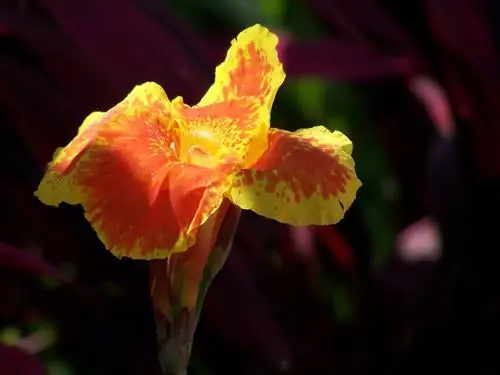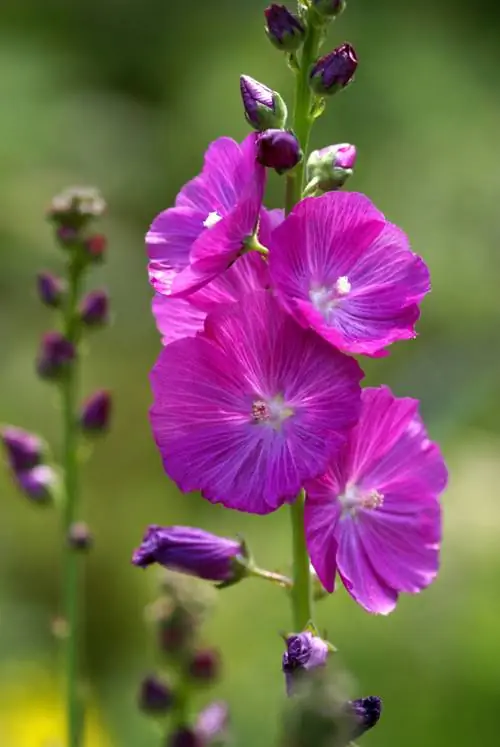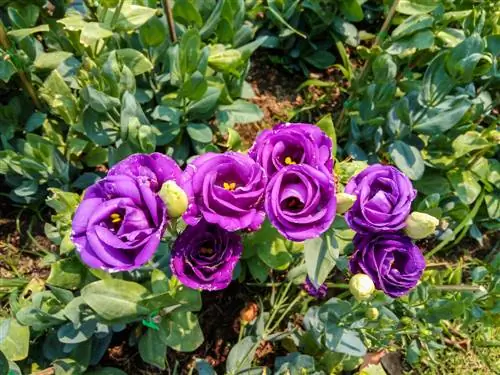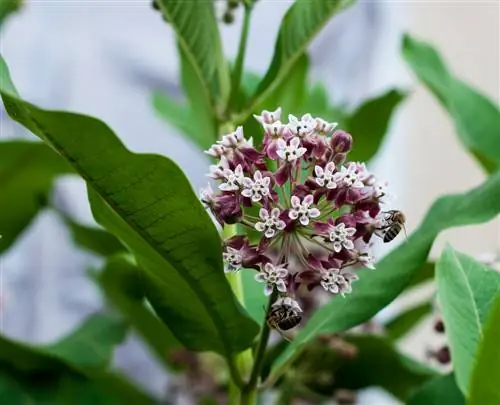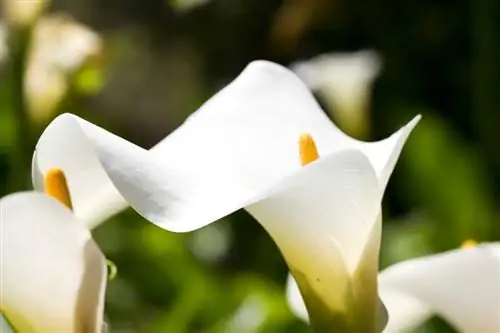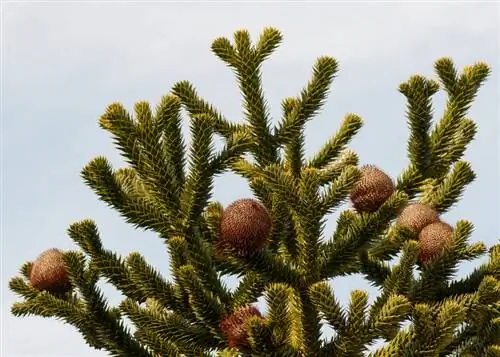- Author admin [email protected].
- Public 2023-12-25 17:45.
- Last modified 2025-01-23 11:20.
With Canna, an exotic South Sea feeling enters the summer garden. Although the cultivation of this plant requires special attention, Indian cane is by no means capricious. The answers to important questions explain how you can meet the requirements of this magnificent flower.
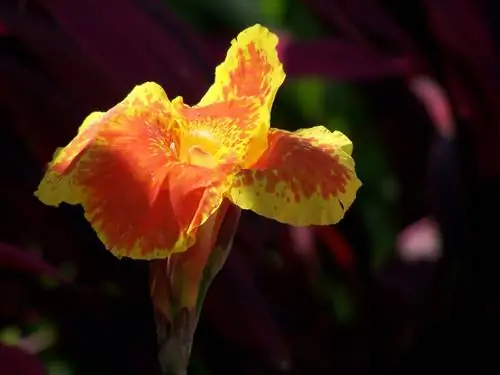
Planting canna correctly
Prepare for planting cane flowers in the fall by digging up the soil and improving it with compost, sand or other soil amendments. If you plant the plant from January onwards, it will start the season with a vital growth lead. To do this, plant a tuber 10-12 centimeters deep in potting soil and start watering when the first shoot tips appear. The planting time outdoors begins in mid-May:
- Dig small holes 50 centimeters apart in a sunny location
- Plant the advanced flower tube as deep as before
- Insert in the pot in nutritious, loose substrate and water
You are free to plant Indian flower cane in the ground immediately without any digging. In this case the flowering starts a little later.read more
Care tips
For your garden to turn into a canna wonderland, the flower needs this care:
- Water the plant abundantly and regularly without causing waterlogging
- From May to August/September, fertilize every 14 days with compost (€12.00 on Amazon), horn shavings or nettle manure
- Alternatively, give the heavily depleting flower cane a slow-release fertilizer every 3 months
- After the first flowering, cut back to 20 cm and cut close to the ground before the first frost
Which location is suitable?
Indian flower cane shows its most beautiful side in full sun, sheltered from the wind. In fresh, moist soil, nutrient-rich and well-drained, the flower happily spreads its roots.read more
What soil does the plant need?
If you pay special attention to the composition of the soil, the plant will thank you with vital growth. These criteria are important:
- Nutritious, humic and well-drained
- Freshly moist, without risk of waterlogging
- In the pot, a structurally stable substrate based on compost, enriched with lava granules
read more
What is the best time to plant?
Since the flower comes from the tropical climate, it is not frost hardy. The planting time for flower cane begins after the departure of the Ice Saints in mid-May.read more
When is flowering time?
The flowering period of Canna extends from June to October. To ensure that you can enjoy this summer blossom magic for such a long period of time, clean out any wilted flowers regularly. If you cut the stem of the plant back to 20 or 25 centimeters after the first flowering, the flower will start again.read more
Cutting canna correctly
After flowering, cut the exotic plant back to 20 centimeters and new flower shoots will sprout. In autumn the flower is cut back close to the ground before it is cleared out.read more
Fertilize canna properly
Indian flower cane is a highly consuming plant with corresponding nutrient requirements. How to fertilize the flower properly:
- Start fertilization in May, parallel to planting
- Subsequently fertilize organically every 14 days with compost, horse manure or guano
- Administer a slow-release fertilizer if desired
- Provide the flower tube in the bucket with liquid fertilizer according to the manufacturer's instructions
read more
Wintering
Every flower tube rhizome contains the life force for several years. Since the plant is not hardy, proper overwintering becomes the focus of interest. How to handle it correctly:
- Cut the plant close to the ground before the first frost
- Dig up and clean the tuber
- Put in a box with sand or peat
- Overwinter in the dark at temperatures of 6 to 12 degrees
While the plant is overwintering, it is neither watered nor fertilized. Check the rhizome for dryness and only spray it with a fine spray if necessary.read more
Propagate Canna
To propagate canna, you have the choice between an uncomplicated division of the rhizome or the complex sowing of seeds.read more
Canna in pot
Dwarf cannas exude their exotic charm in the pot. Plant the tubers in nutrient-rich potting soil in early spring. Don't forget to create a drain made of pottery shards over the water drain. Until the ice saints have said goodbye, maintain the flower tube behind glass in a sunny spot at 20 degrees.read more
Is canna poisonous?
With regard to the toxic content, there are two sides of the coin to consider when it comes to the flower tube. While the underground rhizomes are used in food production, the leaves and stems contain slightly toxic ingredients. These are harmless to humans, but pose a he alth risk to cats and other small pets.read more
Where does the name “Indian flower cane” come from?
The name Indian flower tube for the popular flower is due to its discovery. As early as 1570, the plant found its way from the West Indies to Europe, where it is still used as an ornamental plant today.
The Canna in the garden
Only plant Canna in the garden when there is no longer any risk of ground frost. Only in warm, sun-drenched locations does Blumenrohr spread the longed-for South Seas atmosphere. So that you can enjoy the flower again next year, take the tuber out of the ground before the first frost and leave it over the winter in a dry place at 6-12 degrees.read more
The rhizomes of the canna
Rhizomes have the exciting ability to branch out further and further. Clever hobby gardeners use the cuttings to grow new cannas. After a rhizome has overwintered dry and frost-free, the fresh, pink shoots can be clearly seen. Cut to a length of 10-15 cm and planted from mid-May, a young flower tube will grow from it in the same year.read more
What you should know about canna tubers
Canna tubers are as diverse in shape as the flowers and leaves. What all rhizomes have in common is their underground function as a shoot axis, which constantly produces new offshoots as the next generation during growth. In contrast to flower bulbs, the rhizome of flower cane is not hardy.read more
Is the canna hardy?
Due to its South American origin, the plant is not considered hardy. If the thermometer falls below 10 degrees, flower reeds move to suitable winter quarters.read more
Can you overwinter the canna outside?
Since flower canes fail at temperatures below 5-6 degrees, overwintering outside is out of the question.read more
Overwintering the tubers
If the autumn mood spreads in the garden, overwintering the cane is on the care program. Cut the plant down to the ground and dig up the tubers. After the soil has been brushed off, place the rhizomes in a box with sand or peat moss. The tubers overwinter in a dark place at 6-12 degrees Celsius as dry as possible.read more
Advancing Canna
Promoting a canna gives the plant earlier flowering thanks to the growth advantage. This is how it works:
- Divide the rhizome in January/February
- Plant each section 10-12 cm deep in potting soil
- Wate only a little in the partially shaded, warm window seat
If the first shoots are peeking out of the soil, increase the amount of watering and fertilize with diluted liquid fertilizer.read more
Prefer Canna
So that the cane flowers in beds and pots as early as possible, grow the plant on the windowsill from January/February. For this purpose, place the overwintered rhizome or its sections 10-12 centimeters deep in loose potting soil. At 20-25 degrees in a partially shaded window seat, only slightly moisten the substrate. When the first shoots appear, water a little more heavily and apply the first dose of liquid fertilizer.read more
Planting out the canna
Be patient with planting cane flowers until mid-May. Only when there is no longer any threat of ground frost does the plant move outdoors. Ideally, you harden the sensitive flower the week before by spending the day in a protected, partially shaded spot on the balcony.read more
Planting the Canna
When planting a flower tube bulb, pay attention to the correct polarity and planting depth. The shoot tips must be directed upwards. The rhizome is not inserted into the substrate deeper than 10 centimeters.read more
Share Canna
As the plant's rhizome continually branches in the soil, it provides material for propagation by division. Separate these young, pink offshoots at the end of overwintering. A segment has what it takes to become a new flower if it has at least 2 pointed buds.read more
Bloom
The colorful flower of a canna is enthroned on a tightly upright pseudo-stem, from which the plant owes its name to flower cane. One of the fascinating attributes of this exotic flower is that the petals are shaped differently from variety to variety. Eye-catching specimens impress with large, asymmetrical flowers in two divergent color nuances.read more
Canna seeds
You can harvest ripe seeds from October. They are brown-black, spherical in shape and 4-6 mm small. Thanks to a hard shell, the seeds can be stored for several years. To get the seeds ready to germinate, the sturdy shell should be roughened with sandpaper.read more
Sowing Canna
The hard seed coat of flower cane is roughened with sandpaper or a file before sowing. Then soak the seeds in warm chamomile tea or 0.2 percent potassium nitrate from the pharmacy. After this pretreatment, sow the seeds in the lean substrate and keep them constantly moist at 20-25 degrees Celsius.read more
The Canna varieties
Over the course of 200 years, knowledgeable breeders continually created new canna varieties. Today you are spoiled for choice from more than 1,000 flower cane hybrids. These differ in terms of their height as well as the shape and color of the flowers and leaves. Small varieties reach a maximum height of 60 centimeters, while the giants stretch up to 3 meters towards the sky.read more
The most beautiful varieties
- Louis Corttin: robust breeding with magnificent calyxes in elegant apricot; Growth height up to 50 cm
- White Prosecco: the flower impresses with cream-colored flowers and a robust constitution; Growth height up to 100 cm
- Flamingo striped: magical flower with cream-colored, pink-striped flowers; Growth height 80-100 cm
- En Avant: yellow flowers with red spots over apple-green foliage; Growth height 60-90 cm
- Pink Sunbirst: brand new flower tube with pink flowers and spectacular foliage in green-pink-black stripes; 110-120 cm high

